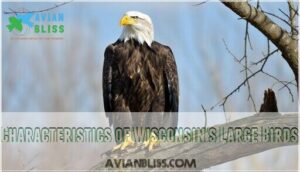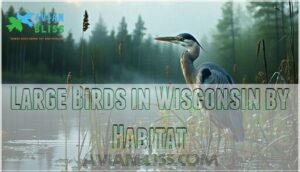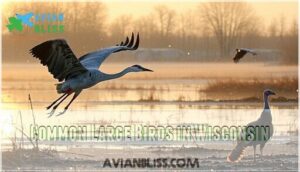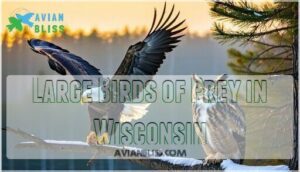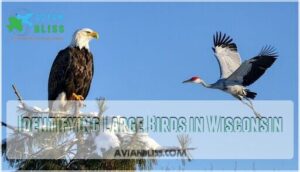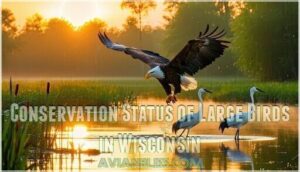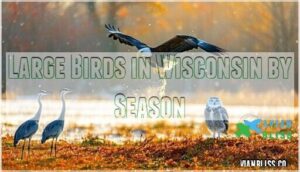This site is supported by our readers. We may earn a commission, at no cost to you, if you purchase through links.

Bald Eagles soar above rivers with their 7-foot wingspans, while Sandhill Cranes dance in wetlands, standing tall at nearly 4 feet.
Great Blue Herons stalk the shallows with prehistoric grace, and Wild Turkeys strut through forests with surprising speed.
The American White Pelican, Wisconsin’s largest flyer, sports a 9-foot wingspan and bright orange bill that’s impossible to miss.
These feathered giants aren’t just big—they’re living wild symbols of the state’s natural wealth.
The trick to spotting these magnificent creatures lies in knowing exactly where to look, and understanding the importance of wild symbols.
Table Of Contents
- Key Takeaways
- Wisconsin’s Largest Bird Species
- Characteristics of Wisconsin’s Large Birds
- Large Birds in Wisconsin by Habitat
- Common Large Birds in Wisconsin
- Wisconsin’s Most Iconic Large Birds
- Large Birds of Prey in Wisconsin
- Identifying Large Birds in Wisconsin
- Conservation Status of Large Birds in Wisconsin
- Large Birds in Wisconsin by Season
- Viewing and Photographing Large Birds in Wisconsin
- Frequently Asked Questions (FAQs)
- What Are Some Tips for Attracting Large Birds to My Backyard?
- What are the big tall birds in Wisconsin?
- What is the big grey bird in Wisconsin?
- What are the big white birds in Wisconsin?
- What are the big brown birds in Wisconsin?
- What big birds are native to Wisconsin?
- What are the largest flying birds now?
- What is the rarest bird in Wisconsin?
- What is the big brown bird in Wisconsin?
- How do large birds impact Wisconsin ecosystems?
- Conclusion
Key Takeaways
- You’ll spot massive birds like Sandhill Cranes, Bald Eagles, and Trumpeter Swans across Wisconsin’s wetlands, lakes, and forests.
- Large birds like pelicans and cranes play vital roles in ecosystems by controlling pests, spreading seeds, and maintaining balance.
- Spring and summer are the best times to see nesting and courtship displays, while winter offers unique views of birds adapting to harsh weather.
- Conservation efforts have helped species like Trumpeter Swans and Bald Eagles rebound, but habitat loss remains a significant threat.
Wisconsin’s Largest Bird Species
You’ve probably noticed some impressively large birds soaring over Wisconsin’s lakes and wetlands.
From the towering whooping crane to the massive trumpeter swan, these giants of the sky are impossible to miss!
American White Pelican
Spotting Wisconsin’s American White Pelican is a feast for the eyes! These massive, gliding giants dominate wetlands like living kites.
Let’s break it down:
- Pelican Diet: Fresh fish stew—scooped from lakes with teamwork.
- Social Behavior: They’re excellent roommates, flocking together to feed and soar.
- Breeding Habits: Remote, peaceful islands? Perfect nursery vibes.
- Conservation Threats: Once endangered, now rebounding with care.
- Plumage Changes: Breeding season brings brighter bills and pouches—nature’s neon signs.
The state’s diverse water bird habitats support a wide range of species.
Don’t pelicans just own Wisconsin skies?
Trumpeter Swan
Trumpeter swans are Wisconsin’s heaviest flying birds, showcasing their elegance with eight-foot wingspans and snow-white feathers.
They’ve made a powerful comeback, a true Conservation Success. These graceful Wisconsin water birds thrive in wetlands, feeding on aquatic plants and grasses.
Their melodic calls, like nature’s song, add magic to the landscape.
Here’s a quick look:
| Feature | Details |
|---|---|
| Length | 58-72 inches |
| Weight | ~25 pounds |
| Wingspan | 84-96 inches |
| Diet | Aquatic plants |
Mute Swan
Let’s talk about the Mute Swan, a stunning yet controversial addition to Wisconsin’s water birds.
With its bright orange beak and graceful S-curved neck, it’s easy to spot.
But don’t be fooled—this invasive species stirs up trouble.
Its aggressive nature and resource-hogging habits outcompete native birds.
Known for feeding on aquatic plants, the Mute Swan’s behavior and impact on Wisconsin birds make it a fascinating yet frustrating sight.
Whooping Crane
The whooping crane stands tall—literally! At nearly 5 feet, it’s not just North America’s tallest bird, but one of the most breathtaking members of Wisconsin wildlife.
Known for their unison calls and elegant “dances,” these cranes rely on wetlands like Necedah and Horicon Marsh to thrive. Thanks to crane conservation and reintroduction efforts, their population has climbed from near extinction.
Keep an eye out in Wisconsin’s marshes for their striking white plumage and graceful movements.
- **Why Protect Them?
- Saved from only 15 birds in the 1940s.
- Essential to endangered birds in Wisconsin.
- Their survival reminds us what’s possible.
Great Blue Heron
If you spot a Great Blue Heron in Wisconsin, consider yourself lucky—it’s like nature’s yoga instructor, calm and purposeful.
With a wingspan stretching over 6 feet, these herons glide gracefully through wetlands, rivers, and lakes, blending elegance with practicality.
Their hunting game is strong; the heron diet includes fish, frogs, and even the occasional snake, all speared with a swift, precise jab of their sharp beak.
When they’re not fishing, great blue herons are busy building large, messy stick nests high in treetops to house their noisy colonies.
- Heron Behavior: Patient, methodical, and surprisingly stealthy while hunting.
- Heron Sounds: Loud, croaky calls echoing over marshes.
- Heron Threats: Habitat loss and human disturbances.
Watching such majestic large Wisconsin birds reminds you how wetlands need protection.
Characteristics of Wisconsin’s Large Birds
When you’re spotting large birds in Wisconsin, their size and features can be pretty impressive.
From giant wingspans to unique beaks and colorful feathers, each species has its own amazing traits you won’t forget.
Size and Weight
Size and weight play big roles for large Wisconsin birds.
Weight variation helps species adapt—pelicans, with surprising bone lightness, gracefully glide.
Hawks rely on compact builds for power and speed.
Sexual dimorphism means males and females often differ in size.
Even juveniles look striking next to adults.
Every Wisconsin bird species is a walking balance of weight, size, and survival perfection.
Wingspan and Feathers
A Wisconsin bird like the American White Pelican wows with its 9.5-foot wingspan, but there’s more to admire.
Feathers play a huge role in flight and survival.
- Broad wings boost flight stability and lift.
- Each species’ plumage coloration aids camouflage or mating.
- The molting process refreshes feathers annually.
- Feather types reveal unique flight adaptations in large birds across Wisconsin’s skies.
Beak Shape and Color
Beak morphology tells you a bird’s story.
Pelicans’ pale, oversized bills showcase feeding adaptations for scooping fish, while herons wield sharp, spear-like beaks designed for precision.
Raptors like Wisconsin’s bald eagles have hooked beaks, perfect for tearing prey.
Bill coloration also helps with species identification—often complementing plumage or age.
Through beak evolution, each shape reflects a survival strategy. Observe carefully, and you’ll uncover nature’s clever system for Wisconsin bird identification, which is based on complete concepts.
Legs and Feet
Let’s talk legs and feet—birds’ unsung heroes in Wisconsin’s wild.
Their foot morphology is fascinating.
- Herons’ long legs handle murky waters as if built for stalking fishy secrets.
- Swans’ webbed feet? Think paddles—they’re pros at lake gliding.
- Sharp claws on hawks and eagles in Wisconsin grab prey like it’s no big deal.
- Cranes strut wetland runways with their leg strength.
- Even owls in Wisconsin showcase unmatched perching ability.
Large Birds in Wisconsin by Habitat
You’ll find Wisconsin’s largest birds spread across habitats like wetlands, forests, lakes, and grasslands.
Each habitat is home to unique species, so knowing where to look makes spotting them much easier (and way more fun).
Wetlands and Marshes
Picture yourself strolling through Wisconsin’s marshes, where wetland ecology comes alive.
Birds like the Great Blue Heron and Sandhill crane glide above, searching for their next meal among vibrant marsh habitats. American white pelicans bill-dip gracefully, while mute swans—striking yet invasive—claim their nesting sites.
These wetlands aren’t just pretty; they’re essential for water quality and avian diets. Protecting these marshes guarantees these fascinating creatures can benefit future generations.
It’s nature’s way of showing off—don’t you love it?
Forests and Woodlands
Moving from marsh to timber, you’ll find Wisconsin’s forests home to majestic birds of prey Wisconsin has to offer.
Great Horned Owls nest high in hollows, establishing territories spanning two miles when prey is plentiful. The elusive Pileated Woodpecker prefers large trees for its nesting habits , while Wild Turkeys raise broods on the forest floors .
Barred Owls master camouflage techniques, blending into shadows while nesting 20-40 feet high in tree cavities.
Wyalusing State Park also attracts nesting southern species. These woodland residents thrive through conservation efforts that protect their natural homes and specialized diet preferences.
Rivers and Lakes
Wisconsin’s rivers and lakes host a remarkable waterfowl abundance where you’ll find stunning aquatic birds in their natural habitats.
While forests shelter woodland species, our waterways offer different viewing opportunities.
River ecology supports diverse bird populations including:
- Great blue herons standing statue-still before striking with lightning precision
- Trumpeter swans gliding majestically across calm waters with their families
- Pelicans working together in synchronized fishing formations
These Wisconsin raptors and waterfowl thrive around healthy nesting sites despite fishing impacts.
Fields and Grasslands
While rivers and lakes host aquatic birds, Wisconsin’s grasslands and farm fields support equally impressive species.
You’ll find majestic Sandhill Cranes wading through prairies and Wild Turkeys foraging in tall grasses.
Agricultural impacts have contributed to grassland bird decline, with many species adapting their nesting strategies to changing landscapes.
Conservation challenges include protecting these vital farmland bird habitats from development and intensive farming practices.
Despite these hurdles, Wisconsin’s prairies remain essential stopover points for migratory species and year-round homes for resilient birds that have mastered life in these open expanses.
Common Large Birds in Wisconsin
You’ll spot impressive birds like Sandhill Cranes, Wild Turkeys, Bald Eagles, and Great Gray Owls during your Wisconsin outdoor adventures.
These magnificent creatures will make you reach for your binoculars faster than you can say "wingspan," so keep your eyes on the skies and your camera ready to capture the wingspan.
Sandhill Crane
During autumn, Sandhill Cranes transform Wisconsin’s wetlands into bustling social hubs.
You’ll spot these elegant birds by their distinctive red crowns and trumpet-like calls echoing across marshes.
- Crane Migration: Thousands form spectacular V-formations during spring and fall journeys
- Mating Rituals: Pairs perform elaborate dancing displays with synchronized jumping and wing-flapping
- Diet Variations: They feast on everything from corn to crayfish
- Nesting Habits: Simple platform nests built among reeds
Wild Turkey
While sandhill cranes gracefully patrol wetlands, wild turkeys rule Wisconsin’s woodlands with their impressive size.
You’ll spot these magnificent birds strutting through forests and fields, displaying their distinctive fan-shaped tails.
Wild turkeys in Wisconsin reach lengths of 43-45 inches and weigh up to 24 pounds, with impressive wingspans of 49-57 inches.
They’re masters of survival, with Turkey Behavior that includes ground nesting and a varied Turkey Diet of insects, seeds, and nuts.
Trait Detail
Length
Weight
Wingspan
Nesting Sites
Diet
Bald Eagle
While turkeys rule the woodlands, the sky belongs to America’s national symbol.
Spotting a bald eagle in Wisconsin feels like witnessing nature’s royalty in action.
These magnificent raptors, with their distinctive white heads and impressive 6-8 foot wingspans, command Wisconsin’s waterways.
They build massive nests (called eyries) that can weigh up to a ton and last for generations.
Wisconsin’s eagle population has soared thanks to successful conservation efforts after nearly disappearing in the 1970s.
Five fascinating bald eagle facts:
- Their diet consists mainly of fish, but they’re opportunistic hunters
- Eagle rehabilitation programs have helped restore populations
- They mate for life and return to the same nesting sites yearly
- Wisconsin raptors population trends show steady increases since DDT was banned
- Their actual call is a soft chirp, not the dramatic screech you hear in movies
Great Gray Owl
The majestic Great Gray Owl soars through Wisconsin’s northern forests like a phantom, standing as North America’s tallest owl at an impressive 33 inches.
You’ll recognize this Wisconsin raptor by its distinctive facial disk, yellow eyes with prominent rings, and massive wingspan exceeding four feet. Despite weighing only about 2.5 pounds, these powerful birds of prey can break through snow-packed surfaces to snatch voles and mice hiding beneath.
Great Gray Habitat typically includes coniferous forests, bogs, and meadows where they employ remarkable hunting techniques, using exceptional hearing to locate prey. Their feather adaptations include fluffy plumage that muffles sound and protects against harsh northern winters.
Though not endangered, Gray Owl conservation faces challenges from habitat loss and climate change. If you’re lucky, you might spot one of these elusive owls hunting at dawn or dusk—a truly unforgettable sight.
Wisconsin’s Most Iconic Large Birds
Five iconic birds define Wisconsin’s natural heritage, each offering unique encounters that birders travel miles to witness.
- Trumpeter Swans – Once nearly extinct, these magnificent white giants now grace Wisconsin’s waterways with their six-foot wingspans. You’ll hear their distinctive trumpet-like calls before spotting them at Birding Hotspots like Crex Meadows.
- Sandhill Cranes Wisconsin – These prehistoric-looking birds perform elaborate courtship dances in spring meadows. Their rattling calls echo across fields as they feed, creating a connection to Local Folklore.
- Bald Eagles – Representing Cultural Significance as America’s symbol, they’re commonly spotted along the Mississippi and Wisconsin Rivers. Their white heads gleam against winter skies.
- Great Blue Herons – These patient hunters stand motionless in shallow waters before striking with lightning speed. You’ll find them stalking fish with prehistoric precision.
The Great Blue Herons nest in colonies throughout the state.
Watch for these iconic species – they’re like Wisconsin’s wild celebrities with wings!
Large Birds of Prey in Wisconsin
You’ll spot Wisconsin’s impressive birds of prey soaring overhead with their massive wingspans that can reach over seven feet in bald eagles.
These powerful hunters, from the lightning-fast peregrine falcon to the silent-flying great horned owl, will transform your casual nature walk into an unforgettable wildlife encounter.
Hawks and Eagles
After exploring Wisconsin’s most iconic birds, let’s look at the powerful raptors that rule the state’s skies. When you spot a hawk or eagle in Wisconsin, you’re witnessing nature’s perfect predators in action.
The Red-tailed Hawk and majestic Bald Eagle are among the most impressive birds of prey you’ll find here. These raptors build massive nests that can weigh hundreds of pounds!
| Raptor | Wingspan | Diet |
|---|---|---|
| Bald Eagle | 72-96 inches | Fish, waterfowl, carrion |
| Red-tailed Hawk | 43-55 inches | Small mammals, birds |
| Golden Eagle | 72-96 inches | Rabbits, marmots, ground squirrels |
During hawk migration seasons, you’ll see these birds soaring on thermal currents. Thanks to eagle conservation efforts, Bald Eagle populations have rebounded dramatically across Wisconsin. Their nesting behavior is fascinating—they return to the same nest year after year, adding new materials each season.
Owls and Falcons
Wisconsin’s owls and falcons represent nature’s perfect hunters.
Owls glide silently through forests while falcons zip through skies at breathtaking speeds.
- Feel your heart race watching a Peregrine Falcon’s 200 mph dive
- Experience the magic of spotting a Great Horned Owl‘s glowing eyes at dusk
- Marvel at the specialized adaptations of these nocturnal hunters
- Connect with Wisconsin’s raptor conservation efforts that saved these magnificent birds
Kites and Harriers
You might stumble upon these elegant raptors while hiking through Wisconsin’s open landscapes.
Northern Harriers cruise low over wetlands with their distinctive white rump patch, while spotting a White-tailed Kite is like winning the birding lottery.
Raptor conservation depends on continued efforts to protect these birds.
| Species | Habitat | Status | ID Tip | Hunting Style |
|---|---|---|---|---|
| Northern Harrier | Wetlands, grasslands (250+ acres) | Uncommon in southern WI | White rump, owl-like face | Low, weaving flight over fields |
| White-tailed Kite | Open country | Extremely rare (3 records) | Hovers in place | Graceful hovering |
| Mississippi Kite | Various | Extremely rare | Elegant profile | Catches prey mid-air |
| Harrier (general) | Wet areas | Endangered in Iowa | Long wings | Listens for small animals |
| Kite (general) | Door County sighting | Five county records only | Powerful wings | Hovering predator |
The conservation of these species is crucial, and understanding their habitat and hunting style can aid in their protection, making raptor conservation efforts more effective.
Characteristics and Hunting Habits
From graceful kites, we now turn to the remarkable hunting habits of Wisconsin’s raptors.
Birds of prey showcase impressive hunting techniques:
- Hawks can spot a mouse from 100 feet in the air
- Great Horned Owls hunt silently with specialized feathers
- Red-tailed Hawks use their incredible eyesight to detect prey movement
- Peregrine Falcons reach speeds of 200 mph during hunting dives
- Bald Eagles use their massive talons to snatch fish from water
You’ll be amazed watching these skilled hunters use their sensory adaptations and flight patterns to capture prey with surgical precision.
Identifying Large Birds in Wisconsin
You’ll quickly become a backyard bird expert when you know what details to look for in Wisconsin’s magnificent large birds.
From the majestic bald eagle’s white head to the sandhill crane’s distinctive red crown, learning these key identification markers will transform those "big bird moments" into exciting species discoveries, making you an expert in species discoveries.
By Color
In Wisconsin bird watching, color provides instant identification clues. You’ll spot raptors with striking white heads (Bald Eagles), hawks with rusty-red tails, and owls in subtle brown camouflage.
Seasonal colors change dramatically—bright breeding plumage in spring fades to muted winter tones. Look for distinctive identifying markings like the Great Blue Heron‘s slate-gray back or the American White Pelican’s brilliant white plumage contrasted with black wingtips.
Many birdwatchers are also interested in attracting red birds to their yards.
By Size and Shape
While color offers clues, size and shape provide reliable ways to identify Wisconsin’s large birds.
You’ll quickly recognize birds by their:
- Relative proportions – compare the neck length to body size
- Wing loading – heavy-bodied vs. lightweight flyers
- Size dimorphism – males often larger than females
- Shape variation – distinctive silhouettes like the pelican’s pouch
Wisconsin’s largest birds include the Trumpeter Swan (wingspan up to 8.5 feet) and American White Pelican (wingspan over 9 feet).
By Habitat and Behavior
While shapes and silhouettes offer useful clues, observing where and how birds behave can be even more revealing.
You can identify Wisconsin’s large birds by watching their habitat preferences and behavior patterns. Eagles and ospreys circle above lakes, swooping down for fish with dramatic plunges. Great Blue Herons stand statue-still in wetlands, demonstrating patience in their foraging strategies.
In farm fields, you’ll spot Sandhill Cranes performing elaborate dancing displays during their social behavior rituals. Turkey Vultures soar on thermals with minimal wing flapping, using distinctive v-shaped flying postures.
Pay attention to nesting habits too—Bald Eagles build massive stick nests in tall trees near water, while Great Horned Owls often take over abandoned hawk nests for territory defense.
Migration triggers vary by species, with some birds responding to day length changes while others react to food availability. Learning these habitat-specific behaviors will transform your bird watching from random sightings to meaningful observations.
By Sound and Call
While visual cues help spot birds, their sounds often reveal them first.
Wisconsin’s large birds have distinctive calls that become your audio field guide.
Listen for these unmistakable vocalizations:
- Sandhill Crane’s rattling bugle that carries for miles
- Bald Eagle’s high-pitched screeches that don’t match their majestic appearance
- Great Horned Owl’s deep "hoo-hoo-hoo" that echoes through forests at dusk
With practice, you’ll identify birds by ear before they come into view, and develop a deeper understanding of their vocalizations.
Conservation Status of Large Birds in Wisconsin
You’ll be amazed at how Wisconsin’s birds like the Bald Eagle and Whooping Crane have bounced back from near extinction, thanks to local conservation efforts.
When you protect their wetlands, forests, and nesting sites, you’re giving these magnificent birds a fighting chance against threats like habitat loss and climate change.
Endangered and Threatened Species
Now you can spot these magnificent birds and understand their struggle.
Wisconsin’s endangered birds face serious habitat loss and climate change. The Whooping Crane population stands at just 70 individuals (36 female, 31 male), while the once-endangered Trumpeter Swan has rebounded to 14,781 birds by 2024, leading to its removal from Wisconsin’s endangered list in 2009.
The Bald Eagle’s comeback story gives hope, while the Peregrine Falcon remains protected by legal protections. Each rare sighting is a gift worth cherishing.
As of December 2024, six cranes resided in Wisconsin.
Conservation Efforts and Programs
While endangered birds face many challenges, Wisconsin’s conservation programs are fighting back with impressive results.
The Wisconsin Bird Conservation Partnership spearheads efforts across the state, collaborating with the Natural Resources Foundation’s Bird Protection Fund to direct resources where they’re most needed.
Through the Great Wisconsin Birdathon, you can join citizen-science initiatives that make real differences for wildlife conservation.
The DNR’s habitat restoration projects, combined with Audubon’s Conservation Ranching program, create powerful protection systems for species that might otherwise disappear from our landscape.
Your participation matters!
Habitat Preservation and Restoration
Habitat preservation fuels Wisconsin’s remarkable conservation success stories. The state’s commitment to protecting large bird populations shows in its extensive restoration efforts.
- Wetland restoration projects revitalize vital breeding grounds for pelicans and herons
- Forest conservation initiatives protect nesting sites for eagles and owls
- River protection measures maintain healthy fish populations for osprey and kingfishers
- Grassland management practices preserve hunting territories for hawks and harriers
- Wildlife corridors connect fragmented habitats for safer migration routes
You’ll see the results firsthand if you visit places like Horicon Marsh, where once-rare species now thrive. Conservation partnerships between government agencies, nonprofits, and landowners have helped species like the trumpeter swan recover from near extinction. These habitats aren’t just for birds—they’re living classrooms for future generations.
Impact of Human Activity on Large Birds
Human activities cast long shadows over Wisconsin’s magnificent birds.
You’ll notice their struggles against our expanding footprint across their traditional territories.
Here’s how we impact these majestic creatures:
- Habitat loss fragments vital nesting grounds as urban areas expand
- Pollution effects contaminate food chains, especially affecting fish-eating species
- Climate change disrupts migration timing and breeding cycles
- Increasing noise and traffic disturb sensitive breeding wildlife
- Collisions with power lines and buildings cause direct mortality
Conservation strategies focus on creating protected corridors between critical habitats.
When you support these efforts, you’re helping endangered birds in Wisconsin navigate our shared landscape.
Large Birds in Wisconsin by Season
You’ll notice Wisconsin’s bird population transforms dramatically with each season, from the majestic Bald Eagles hunting over icy lakes in winter to the colorful parade of herons and cranes returning in spring.
Whether you’re bundled up watching Snowy Owls in December or enjoying Sandhill Cranes dancing in April’s meadows, the Badger State offers year-round opportunities to spot these impressive winged giants.
Spring and Summer
Spring and summer transform Wisconsin into a bustling nursery for dozens of large birds during nesting season.
You’ll see trumpeter swans building massive nests, while great blue herons form noisy colonies in tall trees.
Hawks in Wisconsin actively hunt to feed hungry chicks, their distinctive calls echoing across forests.
Wild turkeys strut with poults in tow through woodland edges, and along waterways, pelicans in Wisconsin gather in white flotillas, scooping fish during peak food availability.
Summer molting leaves evidence of feathers along shorelines, and watch chick development unfold as parents demonstrate fishing techniques – nature’s best parenting classes happen right before your eyes, a true display of nature’s best.
Fall and Winter
During Wisconsin’s crisp fall and winter months, large birds showcase remarkable winter adaptations to combat food scarcity and cold weather.
You’ll witness fascinating seasonal transformations, including various bird species adjusting their behaviors to survive the freeze.
- Bald eagles and hawks in Wisconsin congregate around unfrozen water bodies while Snowy Owls make dramatic appearances
- Trumpeter Swans huddle in thermal springs, their white bodies stark against snowy landscapes
- Great Horned Owls begin courtship hooting in January, well before other breeding changes occur
Bundle up—winter birding offers spectacular sightings when many species adjust their behaviors to survive the freeze.
Migration Patterns and Routes
While following the mighty Mississippi River Flyway, Wisconsin’s largest birds create awe-inspiring migration spectacles each year.
You’ll witness Trumpeter Swans and Canada Geese traveling fixed routes with slight variations based on weather patterns. Migration triggers include daylight changes and temperature shifts, sending birds southward through established corridors.
The Wisconsin River offers critical stopover ecology where exhausted travelers rest and refuel.
Conservation challenges increase as climate impacts alter traditional patterns. Check range maps to pinpoint when massive flocks will pass through your area.
Nothing beats watching hundreds of birds following ancient pathways that remain largely unchanged for centuries, creating awe-inspiring migration spectacles with established corridors, and traveling through critical stopover ecology with massive flocks.
Seasonal Changes in Behavior and Habitat
Throughout the year, Wisconsin’s large birds perform a fascinating seasonal ballet that transforms their behavior and habitat choices.
You’ll witness:
- Breeding Season brings dramatic courtship displays and nest-building in wetlands
- Summer centers around protecting young and exploiting abundant Food Sources
- Fall introduces Migration Triggers like changing daylight and depleting resources
- Winter Survival showcases incredible adaptations as birds concentrate around open water
When habitat availability shifts, these adaptations become essential.
Watch for these changes during bird migration in Wisconsin—particularly around lakes and marshes where ice-free waters become premium real estate.
Viewing and Photographing Large Birds in Wisconsin
You’ll capture Wisconsin’s magnificent birds in their natural splendor if you know when and where to position yourself with the right equipment.
With species like Bald Eagles and Great Blue Herons waiting to fill your viewfinder, your patience will be rewarded with breathtaking images that your friends won’t believe you took yourself.
Best Locations and Times
Now that you’ve spotted those seasonal migrants, it’s time to visit the prime viewing locations.
For spectacular lakeside viewing of pelicans in Wisconsin, Horicon Marsh reigns supreme as Wisconsin’s premier bird sanctuary.
Mid-April to mid-May offers peak migration timing, when the marsh buzzes with activity.
Crex Meadows, one of the top 500 birding sites nationally, delivers wild turkeys and large birds in breathtaking 30,000-acre wetlands.
Don’t miss Trempealeau at dawn—your binoculars will thank you!
For ideal weather conditions, September viewing can’t be beat.
Tips for Birdwatching and Photography
Now that you’ve found the perfect viewing locations, it’s time to sharpen your photography skills. Capturing Wisconsin’s majestic birds requires both patience and preparation.
- Invest in quality birding gear: a telephoto lens (at least 300mm) paired with image stabilization will help you freeze those wing-flapping moments without disturbing natural behaviors. A photographer may want to shop for lenses to improve their equipment.
- Master composition techniques by positioning birds in the frame’s thirds and including their habitat for context.
- Learn to read lighting conditions – early morning’s golden glow works wonders for highlighting feather details of large birds like Bald Eagles and Sandhill Cranes.
Remember, the best bird identification skills come from quiet observation rather than constant movement.
Respecting Birds and Their Habitats
While photographing Wisconsin’s magnificent birds, remember that you’re a guest in their home. Keep to trails to protect fragile wetlands where endangered birds nest. Wisconsin’s DNR recommends staying at least 100 feet away to minimize disturbance.
To enhance your viewing experience, consider using specialized birding equipment.
bird habitats
Support conservation through ethical birding practices and reduce pollution by taking only photos and leaving only footprints.
Equipment and Gear Recommendations
Now that you know how to respect our feathered friends, let’s talk gear! Capturing Wisconsin’s magnificent birds requires the right equipment.
Quality binoculars are your best friend – opt for 8×42 or 10×42 magnification for the perfect balance between clarity and stability. Your Wisconsin bird guide app becomes twice as useful with good glass!
For serious bird watching enthusiasts:
- Invest in a sturdy tripod selection paired with a spotting scope (60-80mm) for breathtaking views of distant eagles
- Choose clothing essentials in muted earth tones – that bright red jacket might as well be a warning siren!
- Pack weather-appropriate gear – nothing ends a birding day faster than being soaked or frozen
Remember, good camera gear needn’t break the bank. Finding the right Wisconsin birding binoculars can greatly enhance your viewing experience. Many birders start with basic equipment and upgrade as their skills grow.
Frequently Asked Questions (FAQs)
What Are Some Tips for Attracting Large Birds to My Backyard?
To attract large birds to your backyard, you’ll need large feeders with appropriate food, water sources like birdbaths, nesting platforms, and native plants that provide shelter and natural food sources.
What are the big tall birds in Wisconsin?
Wisconsin’s gentle giants include the Sandhill Crane (34-48 inches tall), Great Blue Heron (46-52 inches), and Whooping Crane (52 inches). You’ll spot these majestic waders in wetlands throughout the state.
What is the big grey bird in Wisconsin?
You’re probably thinking of the Sandhill Crane.
It’s a tall, gray bird with a red crown and a long neck.
They’re graceful and make loud, bugling calls that echo across wetlands and fields.
What are the big white birds in Wisconsin?
You’re probably spotting whooping cranes or American white pelicans.
They are distinct in appearance: whooping cranes are tall, elegant, and rare, while pelicans have massive wings and funky pouch-like beaks.
Both love wetlands—making your Wisconsin birdwatching adventures unforgettable!
What are the big brown birds in Wisconsin?
If you’ve spotted big brown birds, you’re likely seeing Sandhill Cranes or Canada Geese.
Sandhills are graceful with slender necks, while geese waddle around parks, munching grass like they own the place!
What big birds are native to Wisconsin?
You’ve got some incredible big birds here!
Bald Eagles, Great Horned Owls, and Sandhill Cranes call Wisconsin home.
These majestic natives thrive in wetlands, forests, and open fields, adding wild beauty to the landscape.
What are the largest flying birds now?
The largest flying birds today include the wandering albatross, with a wingspan up to 12 feet, and the Andean condor, spanning over 10 feet.
These giants soar effortlessly, commanding the skies like graceful legends.
What is the rarest bird in Wisconsin?
Finding the rarest bird in Wisconsin is like spotting a needle in a haystack, but whooping cranes take the prize.
These majestic, endangered birds grace wetlands, enchanting anyone lucky enough to witness their beauty.
What is the big brown bird in Wisconsin?
You’re probably thinking of a Wild Turkey.
These massive brown birds strut confidently through Wisconsin’s woods and fields.
With their hefty build, fan-shaped tails, and quirky gobbles, they’re both impressive and a little comical!
How do large birds impact Wisconsin ecosystems?
Large birds keep Wisconsin ecosystems in balance by controlling pests, spreading seeds, and cleaning up carrion.
Bald eagles awe you with their majesty, while vultures are nature’s cleanup crew, ensuring everything stays healthy and thriving.
Conclusion
Picture yourself gazing at the sky as a Bald Eagle soars or spotting Sandhill Cranes dancing in marshes.
Wisconsin’s large birds are a breathtaking mix of power and grace.
Whether it’s the 9-foot wingspan of an American White Pelican or the eerie calls of the Great Gray Owl, these feathered giants tell stories of wild beauty.
Grab binoculars, visit wetlands, rivers, and woodlands, and you’ll uncover amazing moments with large birds in Wisconsin, they’re worth every look!

